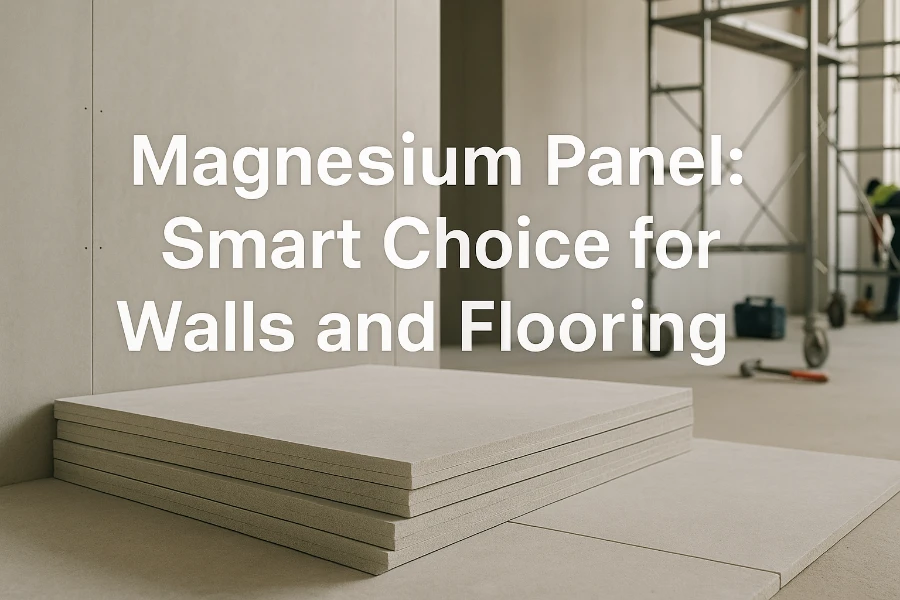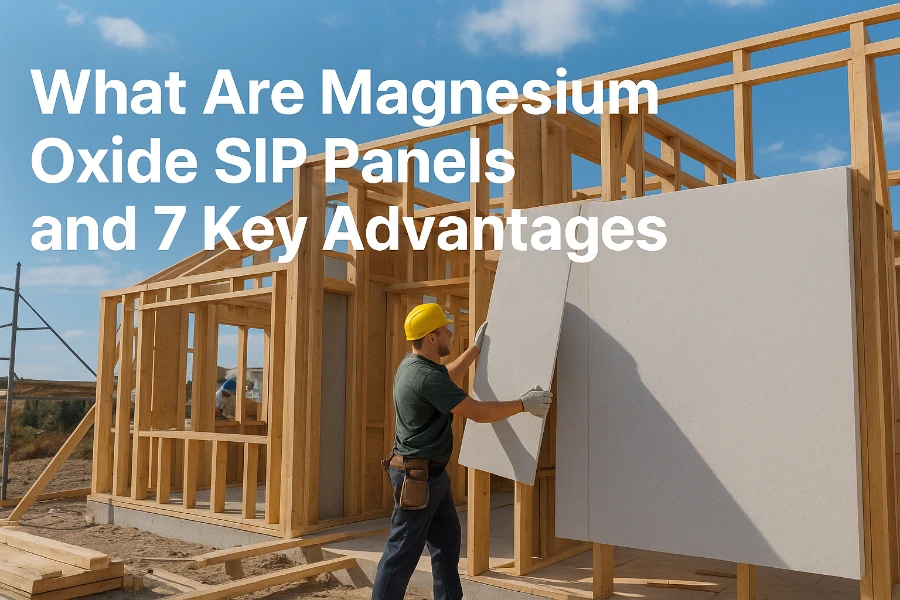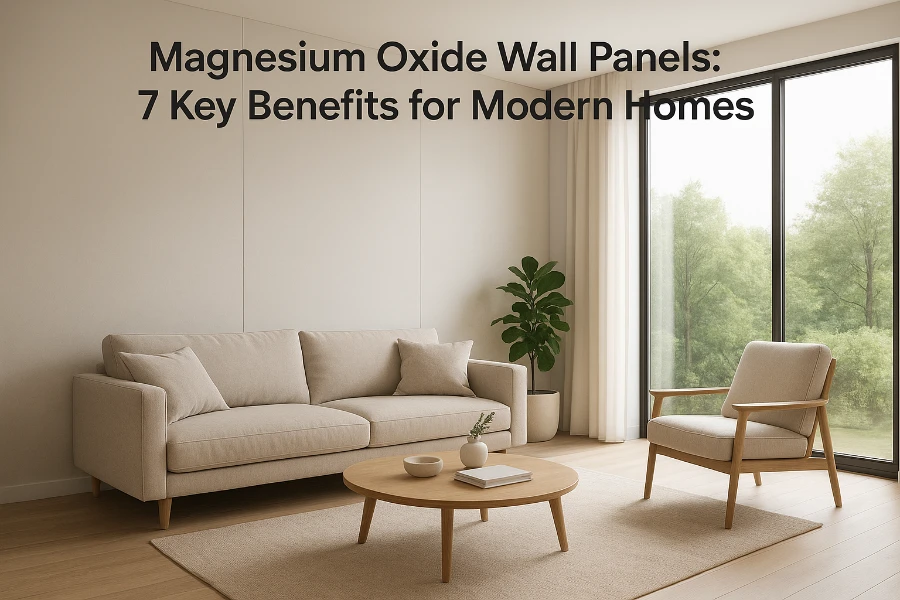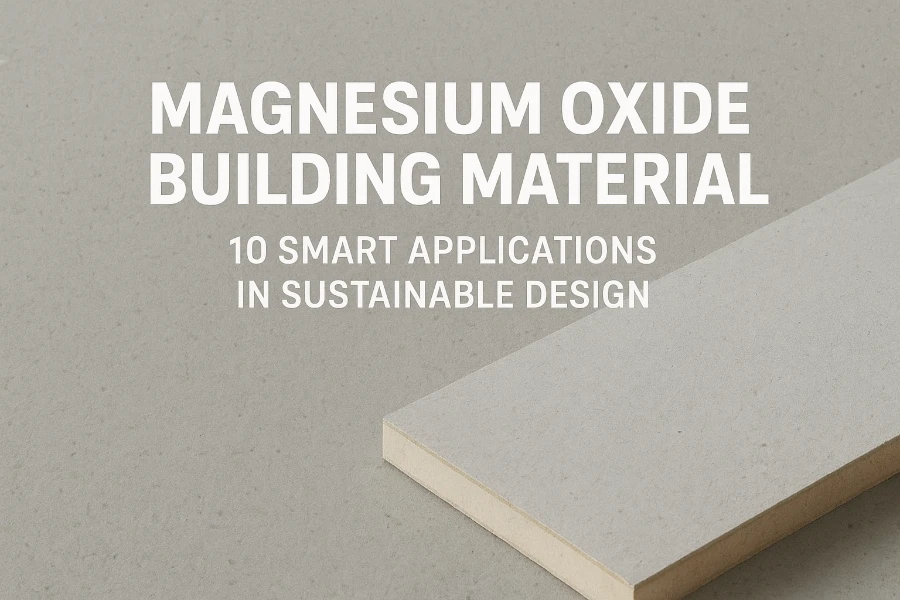Table of Contents
Introduction
In today’s building industry, materials must do more than simply fill space — they must protect, perform, and adapt. Enter the magnesium panel, a modern construction board that combines fire resistance, moisture tolerance, and dimensional stability in a single product. For architects, contractors, and savvy homeowners, a magnesium (oxide) panel offers a practical alternative to gypsum, cement board, or plywood when you need reliable performance and easier installation.
What makes the panel attractive is its balance of technical benefits and on-site convenience. It resists mold and mildew, won’t fuel a fire, and stays flat under changing humidity — all traits that matter most for walls and flooring. At the same time, many systems are lightweight and user-friendly, which speeds up installation and reduces labor costs.
This article focuses specifically on using magnesium panels for walls and flooring. Rather than repeating general “benefits” lists you’ve seen before, we’ll dig into real-world applications: where magnesium panels outperform alternatives, how to specify the right panel for different rooms, installation considerations that affect long-term performance, and finishing options that help you meet both aesthetic and functional goals.
Here’s what to expect next:
-
a clear explanation of what a magnesium panel is and how it’s made;
-
a deep dive into why it’s a smart wall material (fire, moisture, installation, finishes);
-
a practical look at flooring uses (load capacity, stability, underlayment compatibility);
-
comparison with common alternatives and guidance for choosing the right product for your project.
What Is a Magnesium Panel?
A magnesium panel is a construction board manufactured primarily from magnesium oxide, a naturally occurring mineral sourced from magnesite ore or seawater. To improve strength and flexibility, manufacturers typically blend magnesium oxide with fillers such as perlite, wood fibers, or fiberglass mesh. The result is a rigid, durable panel that can be cut, fastened, and finished much like conventional boards, but with enhanced performance.
Unlike gypsum boards, which are prone to moisture absorption, or cement boards, which are heavy and more difficult to handle, magnesium panels offer an appealing middle ground. They are lightweight yet sturdy, easy to install yet built for long-term resilience. This combination of properties explains why magnesium oxide panels are now widely used for both walls and flooring in residential, commercial, and even industrial settings.
From a sustainability perspective, magnesium panels also have an advantage. Their production generates lower carbon emissions compared to many cement-based materials, and they are often made from non-toxic, recyclable ingredients. For developers and builders focused on green certifications or eco-conscious projects, the panels fit neatly into the trend toward sustainable construction.
Another key feature is adaptability. A magnesium panel can be manufactured in different densities, thicknesses, and surface textures, depending on its intended use. Thin, lightweight panels are ideal for partition walls and ceilings, while denser, thicker panels are designed for flooring substrates or areas requiring higher impact resistance. This flexibility allows one product family to cover multiple construction needs, reducing the complexity of material sourcing and handling on-site.
In short, a magnesium oxide panel is more than just another board. It is a modern engineered solution that merges the reliability of traditional materials with the performance enhancements demanded by today’s construction industry. In the following sections, we’ll explore exactly why the panels are considered a smart choice for walls and flooring, and how they outperform conventional alternatives.
Why Magnesium Panel Is Ideal for Walls
Fire Resistance and Safety
When it comes to wall systems, fire protection is one of the most critical concerns. A magnesium panel is inherently non-combustible and can withstand extremely high temperatures without releasing toxic smoke or gases. In fire tests, these panels typically achieve Class A ratings, making them far superior to gypsum board or wood-based panels. For homeowners, this means greater peace of mind. For commercial and public buildings, it often translates into meeting stricter fire codes without additional protective layers. By incorporating magnesium oxide panels into wall assemblies, builders create safer environments while avoiding the cost of extra fireproofing materials.
Moisture and Mold Protection
Traditional wall panels, particularly gypsum, can quickly lose integrity when exposed to moisture. A magnesium panel, however, resists water penetration and prevents the growth of mold and mildew. This property makes it especially valuable in areas such as bathrooms, basements, and kitchens, where humidity levels are high and water contact is more likely. The panel’s stable performance under damp conditions reduces maintenance costs, minimizes the need for repairs, and helps maintain healthy indoor air quality over time.
Lightweight and Easy Installation
Although magnesium panels are dense enough to deliver strength, they remain relatively lightweight compared to cement boards. This balance is important during installation: panels can be easily carried, cut with standard tools, and fastened with screws or nails. Installers benefit from faster handling, and projects move forward more efficiently. Less strain on workers also reduces the risk of errors or accidents, which can delay timelines and add to labor expenses. For large-scale projects, this efficiency quickly adds up to noticeable savings.
Aesthetic Versatility
Beyond performance, walls must also look good. A magnesium panel provides a smooth, uniform surface that can be painted directly, laminated with PVC, or finished with decorative veneers. This adaptability allows architects and designers to meet diverse aesthetic requirements, from sleek, modern interiors to warm, traditional spaces. Unlike plywood, which can warp or show imperfections, or gypsum, which can crumble under stress, magnesium oxide panels offer both a strong foundation and a polished finish.
Why Magnesium Panel Works for Flooring
Strength and Load-Bearing Capacity
Floors endure constant pressure, from furniture and foot traffic to machinery in commercial spaces. A magnesium panel is engineered to handle substantial loads without cracking, bending, or delaminating. Its high compressive strength ensures long-lasting performance, even under heavy usage, which makes it ideal for both residential and commercial flooring applications. Unlike traditional plywood or gypsum underlayment, magnesium oxide panels maintain structural integrity over time, reducing the risk of uneven floors, squeaks, or damage. For builders and homeowners alike, this reliability translates into lower maintenance costs and increased confidence in floor longevity.
Dimensional Stability
One of the biggest issues with conventional flooring substrates is movement caused by moisture changes or temperature fluctuations. Plywood may warp, and cement boards can crack under stress. Magnesium panels, on the other hand, exhibit excellent dimensional stability. They resist expansion, shrinkage, and curling, even in humid environments. This stability not only preserves the quality of the flooring finish but also ensures safety by minimizing tripping hazards or uneven surfaces. Over time, this characteristic contributes to a smooth, durable, and professional-looking floor.
Acoustic and Thermal Benefits
In addition to mechanical strength, magnesium panels enhance comfort through improved acoustic and thermal properties. As a subfloor, they reduce sound transmission between rooms, making them ideal for multi-story buildings or apartments. Their thermal mass can also help regulate indoor temperatures, supporting energy efficiency by retaining heat in winter and limiting heat transfer in summer. These benefits create a more comfortable living or working environment while supporting sustainable building practices.
Compatibility with Finishing Materials
Whether you plan to install tiles, laminate, vinyl, or carpet, magnesium panels serve as a reliable and compatible base. Their smooth surface allows adhesives to bond effectively, while their stability prevents the flooring from cracking or separating. Compared to alternatives like plywood or gypsum board, magnesium oxide panels provide a more predictable and secure substrate, reducing installation problems and ensuring that finished floors remain intact for years.

Other Applications Beyond Walls and Flooring
While walls and flooring are the most common uses for a magnesium panel, its versatility extends to many other areas of construction. One popular application is in ceilings. Magnesium oxide panels provide a stable, lightweight, and fire-resistant substrate for suspended or decorative ceilings. They resist sagging and warping over time, ensuring a smooth, durable surface that supports paints, textures, or even tiles.
Roofing substrates are another area where magnesium panels excel. Their moisture resistance and dimensional stability make them ideal for underlayment in flat or sloped roofs, protecting structural components from water infiltration while providing a reliable base for roofing materials.
In facades and exterior cladding, magnesium panels offer both aesthetic appeal and functional performance. They can be finished with decorative coatings, laminates, or stone veneers, creating modern, clean exteriors while maintaining resistance to fire, weather, and mold. Unlike plywood or traditional fiber cement boards, magnesium oxide panels are less prone to cracking or degradation under outdoor conditions.
Partitions and room dividers also benefit from magnesium panels’ combination of light weight and rigidity. They are easy to cut and install, and they provide strong acoustic separation without compromising safety or fire ratings. This makes them suitable for office spaces, commercial interiors, or even residential layouts requiring flexible room configurations.
In short, the magnesium panel is not limited to a single function. Its adaptability allows one product family to cover multiple construction needs, reducing material complexity, saving time, and offering consistent performance across diverse applications. Builders, designers, and homeowners alike are discovering that investing in magnesium oxide panels can streamline projects while delivering lasting quality.
Comparing Magnesium Panel with Alternatives
Cement Board vs Magnesium Panel
Cement boards are traditionally used for wet areas or floors because of their water resistance and strength. However, they are heavy, difficult to cut, and often require special tools for installation. In contrast, a magnesium panel offers comparable or even superior water resistance while being lighter and easier to handle. Its fire-resistant properties are also generally better than cement boards, making it a safer option for walls and flooring without sacrificing structural performance.
Gypsum Board vs Magnesium Panel
Gypsum boards are cost-effective and widely available, but they have notable limitations. They are prone to moisture damage, mold growth, and reduced fire resistance. A magnesium panel overcomes these issues by resisting water penetration, mold, and high temperatures. Additionally, magnesium oxide panels provide better load-bearing capacity and dimensional stability, which is especially important for flooring and high-traffic areas.
Plywood vs Magnesium Panel
Plywood is versatile and familiar to many builders, but it can warp, shrink, or be damaged by insects and moisture over time. Magnesium panels deliver more consistent performance: they maintain flatness and structural integrity even in humid or heavy-use environments. Moreover, magnesium oxide panels are fire-resistant and environmentally friendly, making them a smarter choice for modern construction projects that prioritize safety and sustainability.
By comparing these common alternatives, it’s clear that magnesium panels combine the best of multiple worlds: lightweight installation, moisture and fire resistance, strength, and versatility. This combination explains why more builders are turning to magnesium oxide panels as a reliable, long-term solution for both walls and flooring.
How to Choose the Right Magnesium Panel for Your Project
Choosing the right magnesium panel can make a significant difference in both the performance and longevity of your construction project. Here are the key factors to consider:
Thickness and Density
The thickness and density of a magnesium panel determine its strength and suitability for different applications. For wall partitions, thinner and lighter panels are usually sufficient, making installation easier and faster. For flooring or areas subjected to heavy loads, thicker and denser panels are recommended to provide maximum strength and stability. Selecting the correct thickness ensures your walls remain rigid and your floors can withstand daily use without cracking or sagging.
Finishing Needs
Consider the type of finish you plan to apply. Smooth magnesium panels are ideal for painting or wallpaper, while textured panels or laminated surfaces work well with decorative films, tiles, or vinyl. The right choice ensures that your finishing materials adhere properly and maintain a flawless appearance over time.
Project Type: Residential vs Commercial
Residential spaces typically require panels that balance performance and aesthetics, while commercial or industrial projects often prioritize load-bearing capacity, fire resistance, and moisture tolerance. Understanding the intended use of the building will help guide your selection and ensure compliance with local building codes and safety regulations.
Budget and Long-Term Maintenance
While magnesium panels may have a higher initial cost compared to gypsum or plywood, their durability, fire resistance, and moisture protection reduce maintenance and replacement costs over time. Investing in the right panel upfront can save money in the long run, offering both economic and functional advantages.
Supplier and Quality Considerations
Finally, always source magnesium panels from reputable manufacturers who provide consistent quality and clear specifications. This ensures that the panels meet safety standards, perform as expected, and integrate seamlessly with other building materials.
By carefully evaluating these factors, builders and homeowners can select the most appropriate magnesium panel for each project, achieving both functional performance and aesthetic appeal.
Conclusion: Building Smarter with Magnesium Panels
The magnesium panel is more than just a construction material—it is a smart investment in safety, durability, and design flexibility. For walls, it delivers fire resistance, moisture protection, and easy installation, ensuring both functional and aesthetic excellence. For flooring, it provides strength, dimensional stability, and compatibility with various finishing materials, making it ideal for both residential and commercial projects.
Beyond walls and floors, magnesium panels excel in ceilings, facades, partitions, and roofing substrates, demonstrating versatility that few alternative boards can match. Compared to gypsum, cement, or plywood, magnesium oxide panels combine lightweight handling, eco-friendliness, and long-term reliability, offering a comprehensive solution for modern construction challenges.
Choosing magnesium panels not only addresses current building requirements but also future-proofs projects by minimizing maintenance, reducing repair costs, and enhancing safety. Whether you are a builder, architect, or homeowner, incorporating magnesium oxide panels into your project ensures stronger, smarter, and safer construction.
Ready to experience the benefits of magnesium panels for your next project? Contact our team today to explore the right products, specifications, and solutions for walls, flooring, ceilings, and more. Let us help you build safer, stronger, and smarter with high-performance magnesium panels.
Discover what are magnesium oxide SIP panels and the 7 key advantages, from fire resistance to durability, and eco-friendly building solutions.
Discover 7 key benefits of magnesium oxide wall panels for modern homes, from fire resistance and moisture protection to durability and eco-friendliness.
Discover 10 smart applications of magnesium oxide building material in sustainable design, from walls, fire-rated doors and prefabricated systems.




